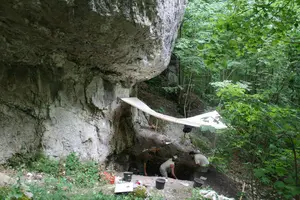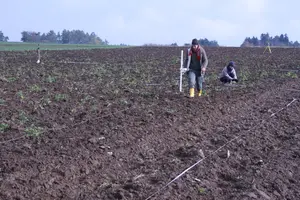Reasons for Studying Prehistoric Archaeology at the University of Bamberg
You can study prehistoric archaeology at more than 20 institutions across Germany. Why choose Bamberg?
- At the Institute for Archaeology, Heritage Conservation Studies and Art History (IADK), Prehistoric and Ancient Archaeology is one out of four archaeological disciplines that collaborate closely and complement each other fantastically. Together with the other two sub-disciplines represented at the University of Erlangen-Nuremberg, with which we maintain a fruitful partnership, they constitute a competence network of seven fields of research that cover the entire history of humanity and is unparalleled in Germany.
- Older Prehistory (Erlangen-Nuremberg; focus: Palaeolithic and Mesolithic)
- Pre- and Protohistoric Archaeology (Bamberg; Neolithic to the migration period/Early Middle Ages)
- Medieval and Post-Medieval Archaeology (Bamberg; Early Middle Ages, High Middle Ages, Late Middle Ages, Modern Era)
- Classical Archaeology (Erlangen-Nuremberg; Greek and Roman Antiquity)
- Christian Archaeology (Erlangen-Nuremberg)
- Archaeology of the Roman Provinces (Bamberg)
- The University of Bamberg’s research in prehistoric archaeology focuses on various sub-disciplines, all of which benefit from decades of expertise and an international network.
- Archaeometallurgy is the study of raw materials, in particular, their production and processing: from the prospection of storage sites to the reconstruction of distribution and trade networks for the finished goods. Previous and ongoing projects focus on iron (Germany, Luxembourg), pewter (Germany, Portugal), bronze (Germany) and gold (Costa Rica).
- Ritual sites and caves, i.e., the use of unusual natural features such as natural spires and potholes for ritual activities during prehistoric epochs. The research focuses on the Northern Franconian Jura.
- Settlement and landscape archaeology, in particular, the archaeology of rural settlements in highland zones (Northern Franconian Jura) from the Neolithic to the Iron Age using state-of-the-art prospection technology and GIS evaluation.
Current example: Bronze and Iron Age Settlement of the Northern Franconian Jura (in collaboration with Digital Geoarchaeology)


- Prehistoric Archaeology at the University of Bamberg has a strong practical and research orientation. Students have opportunities to contribute actively to research projects and participate in the process of producing knowledge from an early point in their studies. Since 2011, our research and teaching has also included experimental archaeology. You can use our own experimental facilities to gain first-hand insights into prehistoric technologies and manual practices, such as ceramics production, iron extraction, bronze casting and forging techniques.
- Prehistoric Archaeology is a small subject at the University of Bamberg. This ensures excellent supervision and a warm atmosphere. Our block classes (practical research and excavations, exercises in the field of experimental archaeology, field trips over multiple days) often constitute excellent opportunities to experience teamwork and the sharing of responsibilities in real life.
- At the University of Bamberg, the archaeological disciplines at the Institute are closely connected with the field of Monument Studies (Heritage Conservation, Architectural Research and History, Digital Heritage Technologies) and Art History, whose Centre for Heritage Conservation Studies and Technologies is unique in Germany and allows students to specialise in heritage conservation to an extent that is not possible anywhere else in the country.
- The town of Bamberg, whose entire centre has been declared a UNESCO World Heritage Site, boasts an almost Mediterranean atmosphere, compact structures, short distances between facilities, and a warm and friendly community – a perfect basis for spending unforgettable student years.